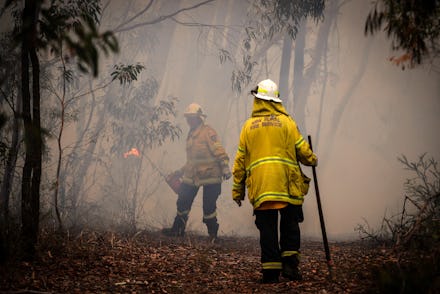Australia’s nightmare summer is only getting worse

It seems difficult to enjoy summertime in Australia right now. Instead of sunny days and beautiful beaches, the season is stricken with dangerously hot temperatures and nearly a hundred bushfires that have covered Sydney, the capital city, in blankets of smoke. And the conditions look like they're only going to get worse. Yesterday, high temperatures broke Australia's heat records at 40.9 degrees Celsius (105.6 degrees Fahrenheit). The Australian Bureau of Meteorology predicts that this extreme heatwave will lead to more exceptionally high temperatures for the next few days.
This is more unfortunate news for a country that is already working night and day to contain its wildfires.
With great heatwaves comes great health risks, too. Extreme temperatures in Europe this year caused farm animals to die, passengers in older train cars to faint, and created health risks for outdoor workers, the elderly, and children. Australia will be facing similar issues for multiple days in a row in December — a first for the country.
"For many areas, severe to extreme heatwave conditions will be felt," cautioned Bureau meteorologist Sarah Scully in a statement. "[I]t's important people follow the advice of health authorities, stay up to date with the latest forecasts and warnings from the Bureau and remember to check in on any vulnerable family and friends."
According to Vice, temperatures usually ramp up during January and February. But the west side of the country has already broken those expectations, and the heat is making its way to the east. Once it reaches the east, it will linger over the area for a few days in what Vice's author described as a "heat dome" — a weather phenomenon that occurs when pressure from the atmosphere traps the extreme heat in place like a cap.
"We saw significant heat build over Western Australia over the course of last week, and that heat is now pushing east over the continent, which is going to lead to several days of exceptional heat," said Bureau climatologist Dr. Blair Trewin. "Australia's warmest day on record occurred in January 2013, when the average maximum temperature across the continent was 40.30 ºC [104.54ºF]. We’re closely monitoring the development and progression of this heat but based on current forecasts we could see that record broken this week."
Firefighters fear the dry heat and lack of rain will only fuel the bushfires even further. The smoke caused by the fires has reportedly been so thick that it set off fire alarms in some homes and public buildings. Emergency services were flooded with calls from asthmatics and other people suffering from breathing problems. Outdoor school activities were cancelled and travel was restricted due to low visibility. The availability of resources that can help people is beginning to strain.
The Sydney Morning Herald quoted the environment minister of New South Wales, Matt Kean, saying that climate change was to blame for Australia's extreme weather conditions.
"This is not normal and doing nothing is not a solution," he insisted to the Herald. He said that the current weather is "exactly what the scientists have warned us would happen" and should make everyone stop to think about what must be done to protect people from harm.
"If this is not a catalyst for change, then I don't know what is," Kean said. "We need to reduce our carbon emissions immediately, and we need to adapt our practices to deal with this kind of weather becoming the new normal."